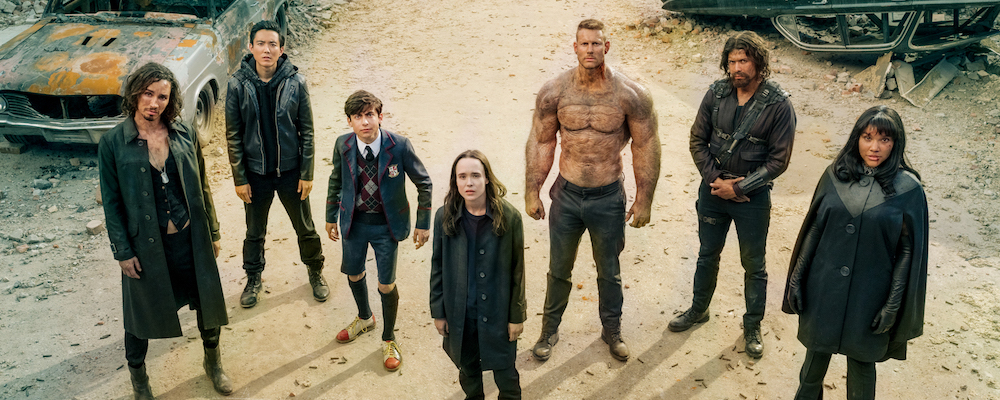‘The Umbrella Academy’ Season 2 Travels Back to 1963 to Stop the JFK Assassination and Avert Apocalypse
Alci Rengifo
Season 2 of Netflix’s “The Umbrella Academy” continues the ongoing trend of nostalgia fetish in superhero streaming. Its main plot thread is an apocalyptic excuse to have fun walking around the early ‘60s, winking at historical events and playing guess who that is trivia. If you know your history, when the characters drop into Dallas, Texas in November 1963, you can instantly guess where this is going.
Last year “Umbrella Academy” was a big streaming hit for Netflix, so rest assured this season delivers the same, somber-lit, slow motion-obsessed opus about dysfunctional heroes chased by disaster. You may recall last season ended with Number 5 (Aidan Gallagher) to time jump the superhero family, the Hargreeves, to safety. Inevitably his trick had an unintended consequence: He jumped everyone to different times around the same era, namely November 1963, the month when President John F. Kennedy was assassinated. But instead, Klaus (Robert Sheehan), Vanya ( Ellen Page), Luther (Tom Hopper), Diego (David Castañeda), Allison (Emmy Raver-Lampman) and Ben (Justin H. Min), are confronted with the possibility that Kennedy is not killed, resulting in a nuclear war between the United States and Soviet Union. They need to prevent this horror from happening. But before that, the family members need to find a way to reunite across separate years.
This season of “Umbrella Academy” surpasses the first in terms of scope. The visual aesthetic remains the same, aping the kind of palette made famous by Zack Snyder in comic book adaptations like “300” and “Watchmen.” This show is culled from a comic book by Gerard Way, of My Chemical Romance, and Gabriel Ba , so it should be no surprise that its visual style compliments its origins. Season one was so gloomy you wondered if anyone, anywhere, is willing to make a sunny superhero show ever again. There are some memorable, CGI-fueled visuals however. The season opener features Soviet troops marching through an American town, and a canon found flying at us in slow motion. One of the Umbrella Academy blocks the shell to the sounds of Fran Sinatra’s “My Way,” because every show about people in tights is trying to copy the “Guardians of the Galaxy” formula. “Umbrella Academy” at its best is fun to just stare at. The production design is stellar when it comes to recreating the ‘60s, or when we revisit the office of The Commission, where the boss has a fishbowl for a head while keeping track of this entity keeping the timeline under control. It is the most inventive form of time travel police to appear in a TV show.
But by separating the family in the ‘60s, the show is free to explore different themes at the same time. Allison finds herself facing the prejudices of the Jim Crow South, realizing that even for someone with powers, racism is an overwhelming threat, particularly in a society where it was literally part of the institutions of law. Diego also gets a more front and center approach, being the main Hargreeve who tasks himself with stopping the assassination. This premise has been done much better in other series, such as Hulu’s great adaptation of Stephen King’s “11/22/63,” where the fantasy elements had a real sense of pathos. Stopping the Kennedy assassination in that story opened wider themes of time’s passing, regret and why things do happen when they are supposed to. “The Umbrella Academy” simply uses it as a tool to pose sometimes illogical questions about time and space. It’s as if the characters need something to keep them going within their premise, so why not dust off the old JFK adventure? Klaus for most of the season does very little. The story angle involving Five also feels a bit off. He’s capable of pulling off incredible feats, yet here the storyline stretches out to overcomplicate the new dilemma. These characters can travel through time, yet somehow find it hard to congregate in Daley Plaza to save Kennedy.
Creators Steve Blackman and Jeremy Slater seem to have stepped into the idea that to keep the show relevant, it needs to be more woke. The scenes involving Allison and the Civil Rights movement are effective as drama, especially when she attends late meetings where racists snoop around. Then she will use her powers of persuasion to influence positive developments for the movement. Allison’s storyline is the best one this season, it speaks to a classic comic book tradition of commenting slyly on social issues. Having superheroes promote equality is a vital pop cultural tool. But the rest of the season can feel like filler. The characters travel across time so often, through eras and decades that we have little doubt the world will be saved yet again. Some of the plot has entertaining flourishes that stand on their own, like Diego stuck in an asylum after ranting about needing to stop the Kennedy murder. David Castañeda shines here with some great, deranged acting.
The fans already garnered by “The Umbrella Academy” will surely find much to like. And these are great actors, always creating a sense of family. At its heart that is the saving grace of this show, how it deals with the idea of dysfunctional families where loyalty still abounds. If it does more of that, and less of the time travel nonsense, it could be onto something the next time.
“The Umbrella Academy” season 2 begins streaming July 31 on Netflix.

